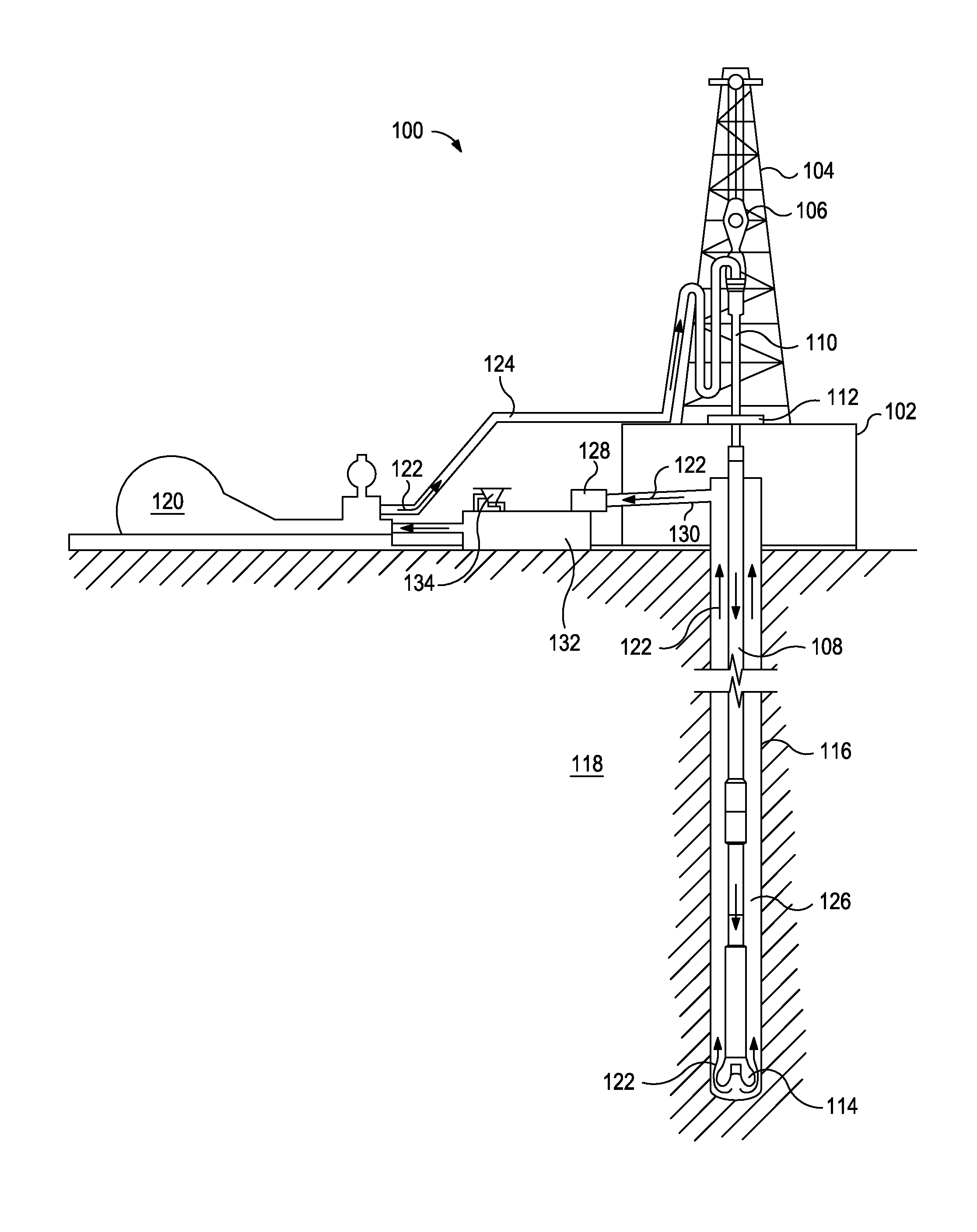Invert Emulsion Drilling Fluids for Flat Rheology Drilling
a flat rheology and drilling fluid technology, applied in the direction of drilling composition, chemistry apparatus and processes, etc., can solve the problems of loss of drilling fluid and other operating problems, the inability to drill a particular portion of a well, and the inability to use drilling fluid. , to achieve the effect of improving the drilling efficiency and safety, and improving the drilling efficiency
- Summary
- Abstract
- Description
- Claims
- Application Information
AI Technical Summary
Benefits of technology
Problems solved by technology
Method used
Image
Examples
experiment 1
[0037] Four 12 ppg Invert Emulsion Fluids (IEFs) were formulated with a 2 ppb C36 fatty dimer diamine in 12 ppg INNOVERT® clay-free invert emulsion drilling fluid (available from Halliburton Energy Services, Inc., in Duncan, Okla. and Houston, Tex.) in a 70:30 oil-water ratio having a 250K ppm CaCl2 Water Phase Salinity (WPS) One of these IEFs included no acid and the other three included acids of the present disclsoure, that is, one included 1.75 ppb vinyl phosphonic acid, one included 5 ppb boric acid, and one included 2.75 ppb paratoluene sulphonic acid. All four fluids were hot rolled for 16 hours at 250° F. and the rheologies determined on a FANN 35 rheometer according to API 13B-2 at 120° F. The results are provided in Table 1.
TABLE 1MixingBase-time, minFluid 1Fluid 2Fluid 3Fluid 4EDC 99DW, ppb148.90149.50149.50149.50EZ MUL ® NT, ppb211.0011.0011.0011.00Lime, ppb21.301.301.301.30ADAPTA ®, ppb52.002.002.002.00Vinyl phosphonic acid,50.001.750.000.00ppbBoric acid, ppb50.000.005.0...
experiment 2
[0039] Experiment 1 was repeated except the rheology of samples of the different fluid formulations were tested at different temperatures for comparison of stability and dependence on temperature. That is, rheology measurements were taken at 40° F., 80° F., 120° F., and 150° F. to determine whether addition of the acid with the fatty dimer diamine would yield or impart better performance, i.e., less temperature dependence, to the invert emulsion fluid. The results are provided in Tables 2 (base fluid), 3 (with adipic acid), 4 (with vinyl phosphonic acid) and 5 (with boric acid).
TABLE 2Mixingtime,minBase-Fluid 1EDC 99DW, ppb148.90EZ MUL ® NT, ppb211.00Lime, ppb21.30ADAPTA ®, ppb52.00CaCl2, ppb529.30Water, ppb84.70Revdust, ppb520.00BAROID ®, ppb10203.20Fatty Dimer Diamine,52.00ppbHot rolled@ 250° F., 16 hrs,40° F.80° F.120° F.150° F.600 rpm156815442300 rpm94473123200 rpm72362215100 rpm4824149 6 rpm15643 3 rpm12532PV63342319YP321384LSYP9422GELS 10 sec12665GELS 10 min14988HTHP, ml / 30 mi...
PUM
| Property | Measurement | Unit |
|---|---|---|
| temperatures | aaaaa | aaaaa |
| pressures | aaaaa | aaaaa |
| temperature | aaaaa | aaaaa |
Abstract
Description
Claims
Application Information
 Login to View More
Login to View More - R&D Engineer
- R&D Manager
- IP Professional
- Industry Leading Data Capabilities
- Powerful AI technology
- Patent DNA Extraction
Browse by: Latest US Patents, China's latest patents, Technical Efficacy Thesaurus, Application Domain, Technology Topic, Popular Technical Reports.
© 2024 PatSnap. All rights reserved.Legal|Privacy policy|Modern Slavery Act Transparency Statement|Sitemap|About US| Contact US: help@patsnap.com










